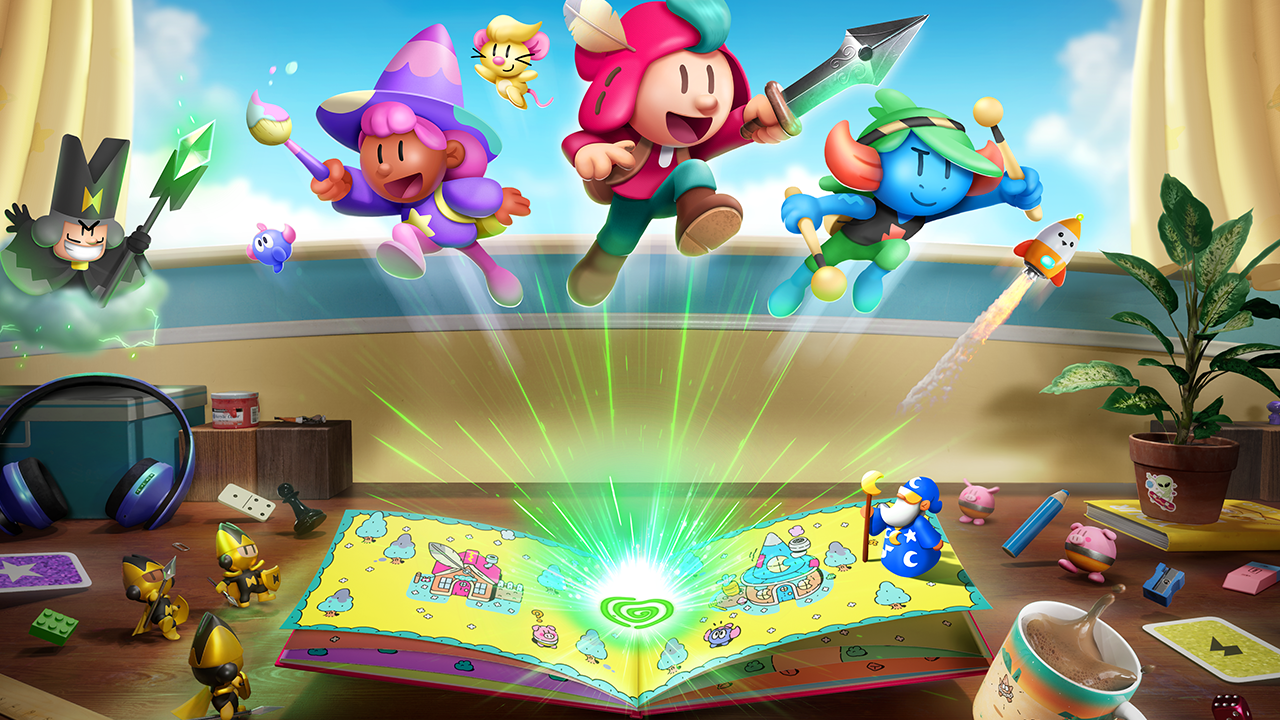The Plucky Squire is a game that will rightly receive a lot of attention for its eye-catching visual gimmick, which merges the worlds of 2D and 3D art around a clever story hook. But more than just its whizbang artistry, The Plucky Squire is a game that takes full advantage of its premise–telling a kid-friendly and heartfelt story, filling its well-realized world with lovable characters, and delivering constant surprises. It is a reminder, appropriately, to never judge a book by its cover.
You play as Jot, the titular “Plucky Squire” in a series of children’s books of the same name. The series of picture books is popular enough to have inspired a large fan base and merch, which is absolutely believable given how playful and inviting it is. While Jot himself is the classic silent protagonist, the surrounding cast of characters are exuberant and frequently funny, and the world of Mojo itself, which the characters occupy, is colorful and imaginative.
Over time, the game reveals itself in layers of complexity. You begin playing through what appears to be a standard top-down adventure game, with the neat visual flourish that screen changes and cutscenes are marked by turning pages of the book. Before long though, the book’s recurring villain, Humgrump, reveals his dastardly plan: the ability to kick Jot out of the book altogether. You’re ejected forcefully out of the book and into the real world. That reveals the second layer, as Jot finds his way back into the book and then gains the power to jump in and out at will, using special “Metamagic” portals. When he jumps out of the book he roams around the desk of Sam, a 10-year-old boy who loves the Plucky Squire books.
I can’t overstate how magical and seamless the transition feels between the two realities. When Jot and his friends are occupying the book, there is a lovely 2D visual language that would be at home in a real-life picture book, complemented by smooth animations and varied behaviors that bring all the characters to life. When Jot jumps out of the book, he magically transforms into a Rankin-Bass model of his 2D self, and the perspective shifts downward for a closer look. The two art styles look beautiful in their own right, while also being visually cohesive with each other. As you gain more abilities you’re able to bring things from the outside world back into the book with you, and they have their own similar transition to the 2D plane.
The story of a protagonist being ousted from his own book, then finding his way back and chasing after the villain, would be compelling enough on its own. But The Plucky Squire adds extra emotional heft by establishing early that you’re not just fighting for the fate of your own storybook. You’re Sam’s favorite book, his favorite hero, and you inspire him to draw his own characters and imagine his own worlds. You can see evidence of how much he loves Jot and the world of Mojo all over his room when you explore his desk. If Humgrump wins, it’s not just Jot’s world at risk, but Sam’s future as a budding artist and writer as well.
Structurally, The Plucky Squire behaves like a mash-up of a 2D and 2.5D Zelda game, albeit with puzzle elements that revolve around the book-jumping gimmick, as you’ll frequently have to jump in and out of the book to manipulate your environment. Since this is a story book, your activities are constantly being narrated, and sometimes even the words on the pages themselves must be manipulated for puzzle solving.
One moment you may be rearranging the words on the page to change an impassable barrier into a broken gate. A few minutes later and you’re hopping outside of the book, trying to find an object that can help you inside the story. Sometimes you’ll need to flip back a few pages to find a missing word you need to complete a word-puzzle. Occasionally the book will even change perspective, turning on its side to present a piece of the stage that is more vertically oriented.
Your ability to manipulate the book gets increasingly complex–eventually you can tilt the book to let objects inside it slide around, freeze certain pieces of the environment to keep them from moving, and even close the book to transfer an object from one page to another. The puzzle solutions hit a sweet spot of tickling your brain without venturing too far into the overly taxing or frustrating. If you do get stuck, there’s almost always a hint totem nearby that will point you in the right direction without entirely spelling out the solution.
The hint system is Minibeard, a miniaturized simulacrum of your wizard mentor, Moonbeard. In the real world he manifests as a piece of merch: a My Talkin’ Minibeard doll. Your other friends, a young witch in training named Violet and a rock-and-roll mountain troll named Thrash, round out the main cast. The land of Mojo has the surreal, comical stylings of a show like Adventure Time, with fun little touches throughout to give it a sense of personality and place. The city of Artia, the royal center of Mojo, is not only composed of artistic tools like paintbrushes, but also full of characters who visually reference famous works of art like Edvard Munch’s The Scream or The Son of Man by Magritte. The mountain trolls are old-school metal-heads, and so many of the trees in their environment take the shape of throwing horns. Every time I thought I had seen everything the world of Mojo had to offer, it threw a new surprise that made me smile.

That’s true for the gameplay as well. The Plucky Squire takes full advantage of its meta-breaking premise to introduce loads of variety that break up the pacing. In one early example, you need to venture outside the book to find a bow from a nearby elven huntress, only to discover that the one you’re searching for resides in a Magic The Gathering-like CCG card. So you leap into the card and engage in a simple turn-based RPG battle to earn her bow. This only happens once in the game, and then it’s off to the next activity. At another point, you jump into a spaceship mug and the game briefly turns into a side-scrolling shoot-em-up. Jot and his friends take part in boss battles that resemble Punch-Out, a color-matching puzzle game, and a rhythm game. It’s genre tourism, but each of them is so well-crafted that they’re more than welcome as breathers for the main adventure.
The result is a game that feels anchored safely in classic Zelda-like mechanics, while also allowing itself to be bursting with new ideas and creative touches that make the world lively and distinct. Those ideas continue right up until the final boss encounter, which introduces yet another new gameplay type that feels wholly different from everything that came before. This can be a risky proposition, as often games that venture too far outside their core mechanics at the very end can feel tacked on or lacking confidence in a finale. Thankfully, The Plucky Squire put just as much care and craftsmanship into this as it did its other genre experiments, helping it to feel like the culmination of a grand storybook adventure.
The Plucky Squire is a joyful story about creativity and inspiration that is itself both creative and frequently inspired. In the world of the game, The Plucky Squire is a beloved franchise and popular character with multiple entries in his long-running series. Here in the real world, he deserves to be a star too, and I can only hope this is the start of his success story.






